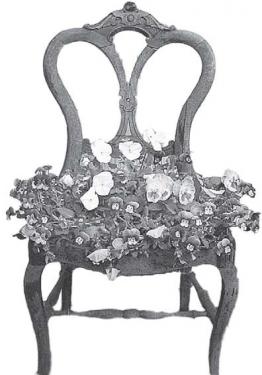
An old cane bottom chair can be made into a lovely and whimsical planter. To learn more about this one created by Susan Borgan, see www.tpartyantiques.com .
High Country Gardener
By Michelle Maga
Thinking Outside the (Planter) Box
I am as guilty as the next gardener when it comes to conforming to traditional containers for plants and trees. You’ll see me strolling down the aisles of the big box stores with plastic faux barrels stuffed into my cart. After painstakingly settling my plant treasures in their new homes, I stand back and look at the overall effect. Disappointment sets in.
I have profound admiration for the individual who can see something as ordinary as an old wheel barrow or cast off car tire rim and turn it into a whimsical resting place for posies or a piece of garden art. That being said, too much of a good thing can be as tasteless as a junkyard. Creating that eclectic mix of whimsy and the traditional is an art form.
If scouring antique and collectable stores is your thing, there are endless opportunities awaiting freethinking gardeners. An old kitchen chair or milk stool with a cutout in the seat becomes a planter fit for cascading ivy or some of the new mini petunias. Old horse feeders used for hay that are attached to the side of a building create a delightful dwelling for bright red geraniums. If you’re lucky enough to find old millstones or rusted metal salvage, this "tramp art" can be transformed with just the right plant.
Whichever container you decide on, make sure it will be sturdy enough to hold the plant and will drain properly. Wood can deteriorate, so if possible, coat the inside with something like roofing mastic which will slow the decay process. [You can see how to make the chair shown above at the site of Susan Borgan. ]
Potting mix is the most appropriate medium for container plants. It has fast draining properties and some of the newer brands contain slow release fertilizer. If fertilizer has not been added, it will be necessary to feed your plants monthly with a granular type fertilizer or according to the instructions on the bag of time release varieties.
When selecting your plants, think multi directional. Put tall plants in the center surrounded by smaller plants on the outer edges. Cascading vines or creeping varieties like thyme, moneywort or ivy tucked in between will add dimension and interest. Keep in mind the finished product may look sparse to begin with, but it doesn’t take long for most plants to fill in.
The old adage, ‘One man’s trash is another man’s treasure’ couldn’t be more true when it comes to thinking outside the planter box!
This is part of the January 28, 2011 online edition of The Mountain Enterprise.
Have an opinion on this matter? We'd like to hear from you.


